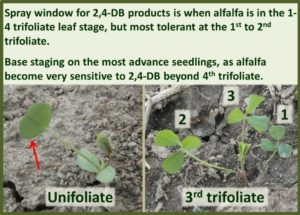With warmer temperatures and recent rains, the alfalfa and grass growth and development is now advancing rapidly, despite a slow start in early April. Older, less healthy stands are beginning to become yellow with dandelions. Many fields that were fall cut are seeing delayed growth that will likely result in reduced 1st-cut yields. Grass stands have responded very well to early applied nitrogen with significantly more growth. Most new seedings are in the ground under excellent conditions. With good overwintering, excellent seeding opportunities and strong seed sales, forage acreage appears to have increased. There was some frost May 14th, but likely with very little damage to established alfalfa stands and new seedings. (“Frost Damaged Alfalfa” http://fieldcropnews.com/?p=6812 )
Weed Control In New Seedings
Many new seedings have emerged with some at the unifoliate stage. Watch new seedings closely for the growth stage and annual broadleaf weeds to determine the optimum time of spraying. The risk of injury to alfalfa seedlings is greatly increased when 2,4-DB application is made outside of the first- to the third-trifoliate stage window. Target the first-trifoliate stage, where weeds are smaller and easier to control. 2,4-DB can suppress legume growth for a period of 2 – 3 weeks and severe injury can occur under drought or high temperatures. Grower experience has been that injury to seedling alfalfa plants can be minimized when reducing the lowest labelled rate of 2,4-DB by 25%. A reduced rate may reduce the level of weed control. MCPA can be added to 2,4-DB where mustard is a problem. Refer to OMAFRA Publication 75, Guide To Weed Control. http://www.omafra.gov.on.ca/english/crops/pub75/pub75ch10.pdf

Watch Forage Rye & Triticale Maturity
The fall rye is growing rapidly with advancing maturity. The timing of cutting is critical. Forage quality, palatability, and intake drop very quickly with rye at the heading stage (faster than other cereals) so the optimum harvest window is very narrow. Many dairy farmers target harvest at the flag-leaf stage for high nutrient quality. Delaying harvest to early-head will reduce digestible energy, but increase yield. (Double Cropping Fall Rye For Extra Forage” http://fieldcropnews.com/?p=5241 )
Monitor Alfalfa Maturity For Dairy Haylage
Dairy producers are monitoring alfalfa maturity and will begin harvesting haylage soon. Maturity of alfalfa is extremely variable, so cutting according to a calendar date may not result in optimum fibre levels or forage quality. Growing Degree Days are currently normal. Scissors Cutting and PEAQ (Predictive Equations for Alfalfa Quality) Sticks are methods used to determine when to harvest for optimal quality. (Using “Scissors Cutting” To Optimize Forage Quality http://fieldcropnews.com/?p=2610 )
Tissue Test For Sulphur Deficiency In Alfalfa
There are more situations in Ontario where there is a yield response from applying sulphur (S) to alfalfa. Some field trials have had quite dramatic yield increases, while others have shown no response. S deficiencies are more likely to occur on low organic matter soils, and soils that have not had a recent manure application. There currently is not a reliable soil test for S in Ontario. Tissue testing of alfalfa (at mid-bud to early-flower stage) is a suitable diagnostic to determine S deficiencies. Sample the top 6 inches of 30 – 40 stems and send them to a laboratory. The critical level below which alfalfa is considered S deficient is 0.25%. S deficient alfalfa plants will be spindly and light-green. (Sulphur On Alfalfa http://fieldcropnews.com/?p=9092)
Keep On Eye On Marginal Stands
Marginal stands are sometimes left to reassess for plant health and yield potential after an early 1st-cut. Dig some plants and cut open the root and crown with a knife. Watch for crown and root rots, brownish disclouration, spongy texture, a lack of secondary roots and nodulation, and assymetrical crowns. As a general rule, at least 55 stems per square foot provide a maximum yield. The critical level of 40 stems per square foot or less will result in a 25% yield reduction and should be rotated. Stem count numbers assume no significant additional yield contribution from grasses. Refer to “Check Alfalfa Stands and Make A Plan” http://fieldcropnews.com/?p=5845.
Alternate Forage Options
New seedings of alfalfa mixtures and cool-season forage species such as cereals and peas done after mid-May do not do well in hot, dry summer weather, so late spring seedings should be avoided. Summer seedings of alfalfa are typically more successful than late spring seedings. (“Summer Seeding Alfalfa” http://fieldcropnews.com/?p=3316 ) After late-May, a better option to produce a decent yield of summer forage is to plant some warm-season forage such as sorghum-sudangrass. Sorghum-sudangrass can yield well well with good agronomics and harvest management. (“Forage Sorghum-Sudangrass” http://www.omafra.gov.on.ca/english/crops/facts/98-043.htm)
Some acres of winter injured alfalfa were repaired by no-tilling in some Italian ryegrass. Westerwold ryegrass is a true annual that will head during the year of seeding, whereas Italian Ryegrass will not. (Italian Ryegrass Forage Options http://fieldcropnews.com/?p=9014 and Annual Ryegrass For Stored Feed and Pasture http://www.omafra.gov.on.ca/english/crops/facts/98-039.htm)
Early Pasture Management by Jack Kyle, Pasture Specialist
The rains this past week have given the pastures a needed boost. Growth in many pastures had slowed due to the dry soil conditions. Management during the first round of rotational grazing will affect the productivity of the pasture for the rest of the season. One of the common mistakes is not rotating quickly enough between paddocks. Livestock should be rotated quickly through the paddocks so that all plants have been bitten off before they have an opportunity to produce a seed head. This can be achieved by quick moves – every day or by increasing the size of the paddocks if moving every 3 or 4 days. Remember the phrase “the faster the grass is growing the faster the rotation”. The last paddock in the rotation should be grazed before any seed heads emerge. If the early flush of grass gets ahead of the livestock, consider bypassing a couple of paddocks completely, harvest an early cut of hay/haylage, and graze the second growth. This harvested forage can be used to supplement the pastures during the mid-summer slump, or saved for winter feed.
Source: Fieldcropnews